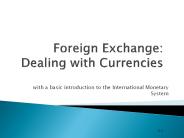Foreign Exchange Risk - PowerPoint PPT Presentation
1 / 7
Title:
Foreign Exchange Risk
Description:
Foreign Exchange Rate. the price of one currency measured (denominated) in another ... need to exchange one currency for another at some point in the future ... – PowerPoint PPT presentation
Number of Views:113
Avg rating:3.0/5.0
Title: Foreign Exchange Risk
1
Foreign Exchange Risk
- The likelihood and severity of losses caused by
changes in the relative price of foreign
currency. - Foreign Exchange Rate
- the price of one currency measured (denominated)
in another - all foreign exchange (F/X) rates are relative
- all F/X rates can be expressed in two ways
- British pound and U.S. dollar
- 1.00 US 1.60 ? US 1.00 0.625
- 0.625 1/1.60 (reciprocals)
- Some reasons for changes in F/X rates
- macroeconomic fundamentals
- balance of trade
- speculative pressures
- flight to quality
2
Foreign Exchange Risk
- Types of F/X risk
- transaction exposures
- need to exchange one currency for another at some
point in the future - translation exposures
- need to restate earnings or asset values from a
foreign currency into the domestic currency - Sources of F/X risk exposure
- overseas investment with local funding
- exposure is the expected gross return of the
investment (loan) credit risk of investment
complicates F/X risk measurement/management - local investment with overseas funding
- exposure is the promised gross cost of the
funding exposure is certain - overseas investment with overseas funding
- exposure is the expected net return (expected
investment return less funding cost) - smallest level of F/X risk
3
Measuring F/X Risk
- grid approach w/maturity buckets separate
currency exposures - assumes all F/X is with one home currency
- positive need to buy, negative need to
sell - can be more complicated if F/X needs include
other combinations (e.g., ? , as well as ?
and ? ) - each point in the grid can be managed with
futures and/or options, if the size of the
exposure is large enough
4
Managing F/X Risk
- F/X futures forwards
- from the grid, the size, direction, and date of
the exposure is known - enter agreement to purchase (long) or sell
(short) the currency - Options on F/X futures
- start with the size, direction, and date of the
exposure (from the grid) - decide the extent to which F/X rate can move
before unacceptable losses accrue - purchase appropriate calls or puts
- F/X swaps
- useful if faced with a periodic, relatively
stable need to buy or sell a foreign currency
5
F/X Futures Forwards
- Hedging with F/X futures
- a British company will pay us 4.3 million on
October 20th, on which date we intend to convert
the entire amount into US. - we do not want this F/X risk, so we intend to
enter into futures contracts sufficient to
eliminate it - CME trades a contract with expiration every 3
months (Mar/Jun/Sep/Dec) on 3rd Wednesday - contract size is 62,500. 4,300,000/62,500
68.8 or 69 contracts - long buy , so we want to short (sell pounds)
- closest maturity is September contract (or could
use December) - Notes
- amount not exact
- date not exact
- residual risk but much less than without the
hedge - What happens if the company doesnt pay us the
4.3 million?
6
F/X Futures Forwards
- F/X forward exchange rates
- cost of carry model ? Interest Rate Parity theory
- Choice 1
- invest in the domestic riskless bond for T
periods - Choice 2
- buy foreign currency
- invest in foreign riskless bond for T periods
- sell (known amount of) foreign currency proceeds
using a forward agreement - as long as both bonds are perceived as truly
riskless and transactions costs are low, these
should be equivalent
7
F/X Futures Forwards
- (1rD,T)T 1/S0 (1rF,T)T F0,T
- rD/F,T is the domestic/foreign T-period riskless
rate - T is the maturity
- S0 is the current spot exchange rate
- units of domestic currency per unit of foreign
currency - F0,T is the current forward exchange rate for
delivery at T - units of domestic currency per unit of foreign
currency - F0,T S0 (1rD,T)/(1rF,T)T S0 (1C)T
- Example
- 2-year riskless rates are 4.0 in U.S. and 1.0
in Japan - Spot exchange rate is US0.0085/yen
- F0,T US0.0085 1.04/1.012 US0.0090































